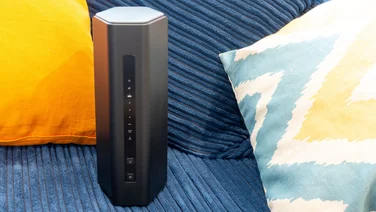To help us provide you with free impartial advice, we may earn a commission if you buy through links on our site. Learn more










- Easy setup and management
- No-nonsense design
- USB storage feature
- Disappointing download speeds
- Slightly basic feature set
- Clunky web interface
We’ve been waiting a long time for Linksys to bring us a Wi-Fi 6E router. The Hydra Pro 6E is the company’s first 6GHz product and although it’s been available in the US since late 2021 it’s taken more than a year to reach the UK.
While the delay has been frustrating, it does mean we don’t have to stomach early-adopter pricing; the UK launch price of £272 is very competitive for a 6E router. Unfortunately, that low price is reflected in the router’s performance. I found the Linksys Hydro Pro 6E nowhere near as fast as the best of the competition. It’s not a disaster, but it doesn’t deliver enough of an advantage over regular Wi-Fi 6 to justify the price.
READ NEXT: Our guide to the best Wi-Fi routers to buy
Linksys Hydra Pro 6E review: What you need to know
The Hydra Pro 6E is a tri-band Wi-Fi 6E router. It operates on the standard 2.4GHz and 5GHz radio bands and adds a 6GHz transmitter to enable the fastest possible connections for 6E-compatible devices. The 6GHz band will also be usable by Wi-Fi 7 devices once they start to appear, probably towards the end of 2023.
Indeed, the hardware specification is quite forward-looking, which is to say, 2.4GHz and 5GHz performance appears to be a low priority. Those radios run at bog-standard speeds – 600Mbits/sec and 1.2Gbits/sec respectively – while 6GHz connections are supported at a maximum 4.8Gbits/sec, with the assistance of 4×4 MU-MIMO.

The design also allows for future expansion by adding extra units, to turn the Hydra into a mesh system. Linksys doesn’t make any specific promises about how far you can extend the system, but the router on its own claims coverage of up to 250m², serving up to 55 clients.
Wired connectivity meanwhile is quite decent. The WAN port can run at up to 5Gbits/sec, although client sockets are limited to gigabit speeds. There’s also a USB-A socket, running at 5Gbits/sec, which you can use to share files across your network.
Linksys Hydra Pro 6E review: Price and competition
The Hydra Pro 6E is the cheapest Wi-Fi 6E router we’ve seen. The Netgear Nighthawk RAXE300 costs £350, while the gamer-oriented Asus ROG Rapture GT-AXE11000 comes in at £470, and Netgear’s top-of-the-line Nighthawk RAXE500 is £490.
The only rival in the same price range is TP-Link’s new Archer AXE75, which is starting to appear at online retailers for as little as £206. Its 6GHz radio is rated at a slower 2.4Gbits/sec, however, suggesting more of a performance compromise.
If you’re not wedded to Wi-Fi 6E, you could also consider the Asus ROG Rapture GT-AX6000, which wrings exceptional speeds out of a regular Wi-Fi 6 connection, although at £300 it’s pricier than the Hydra Pro 6E. A cheaper option with fine performance is the £135 Asus TUF Gaming AX5400.
For better whole-home coverage, you might consider a Wi-Fi 6E mesh. The Google Nest WiFi Pro is aggressively priced at £380 for three units but performance is disappointing. A better option is the TP-Link Deco XE75, which provides faster downloads and costs £345 for two stations. The best-performing Wi-Fi 6E mesh currently is the Netgear Orbi RBKE963, but at £1,699 it’s not a realistic option for most people.
READ NEXT: Our guide to the best Wi-Fi routers to buy
Linksys Hydra Pro 6E review: Design and features
The Hydra Pro 6E has a slightly bulging wedge-shaped design, in sombre black with a brooding blue LED at the front. At the rear, each Ethernet port has link and activity LEDs, and there’s even a light for the USB port. While not huge, the unit is substantially sized, with a footprint of 280 x 170mm. Forget designer chic; this is a serious piece of networking hardware.
Setup is gloriously easy via the Linksys mobile app. Your phone detects the router via Bluetooth, so all you need to do is enter a network name and passphrase and you’re done.
The app then becomes your main management portal, from which you can configure IP address settings and advanced Wi-Fi options, including whether you want to split the three radio bands into separate SSIDs, or broadcast them under a single name and let the client and router work out the best connection for themselves.

A simple parental control module is offered, too, allowing you to suspend internet access for certain devices according to a custom schedule, and block access to specific websites. You can’t set cumulative usage limits, however, and there’s no way to restrict sites by category; you have to enter specific URLs. The system doesn’t support user profiles either, so if your child has multiple devices, you have to set the restrictions individually for each one.
QoS prioritisation is similarly basic: you can nominate up to three devices as high-priority, but you can’t get any more granular than that, nor promote particular protocols or applications. There are no security functions to speak of beyond a simple firewall, nor any support for VPN connections coming into, or out of, your home network.

For those who prefer to use a desktop browser, the familiar Linksys Smart Wi-Fi web interface is also available. As usual, though, navigation can be a bit of a chore, as the various functions are spread across ten pages and clicking around them is distinctly sluggish. You’ll have a much better time if you stick to the app.
Linksys Hydra Pro 6E review: Performance
To test the performance of the Hydra Pro 6E, I set up the router in my study at home, with an Asustor Drivestor 4 Pro NAS appliance connected to one of the gigabit Ethernet ports. I then connected to the wireless network from a test laptop, equipped with an Intel AX210 Wi-Fi 6E card.
With this done, I tried copying a set of 100MB files to and from the NAS in various locations around my home, using both the 5GHz and 6GHz networks, and measured average upload and download speeds. Here are the results I saw, along with a selection of competing routers for context:


There’s no denying the benefit of Wi-Fi 6E. On average, my downloads from the Linksys were around 40% faster over a 6GHz connection than on the 5GHz band. Even at its best, though, the Hydra Pro 6E proved a disappointing performer. The Asus TUF Gaming AX5400 gave me faster downloads in almost every room, despite being limited to the 5GHz radio frequency band.
When stacked against the top 6E routers, the Hydra is completely outclassed. The Netgear Nighthawk RAXE300 smashed the Hydra Pro 6E’s download speeds across the board and the RAXE500 raced even further ahead.
One crumb of comfort for Linksys is that its Hydra Pro 6E did largely match the performance of the pricier Asus ROG Rapture GT-AXE11000. However, that’s not a router we’ve ever strongly recommended, precisely because of its mediocre speeds.
It’s also worth highlighting that, while the Hydra Pro 6E supports 4×4 MIMO, my test laptop is limited to 2×2 multiplexing. You might see faster speeds from the Hydra if you pair it with a 4×4-capable client, but the great majority of phones and computers will have the same MIMO capabilities as my laptop. I should also mention that the Hydra is one of the most energy-hungry routers around: I measured it idling at 13.1W, rising to a peak of 15.9W during testing.
Linksys Hydra Pro 6E review: Should you buy it?
The Hydra Pro 6E is attractively priced but it’s nowhere near as fast as the best 6E routers. In fact, it struggles to keep up with the best routers using regular Wi-Fi 6. That makes the whole exercise a bit pointless, since the only reason for using the 6GHz radio band is the promise of higher speeds.
If you want to enjoy the full potential of Wi-Fi 6E, therefore, you’ll have to pay more. The Netgear Nighthawk RAXE300 is the obvious place to go if you’re looking for a standalone router with 6GHz capabilities. It’s quite a bit more expensive but you can’t argue with the performance.
Alternatively, if you don’t need top performance, you might as well save your money and stick with a conventional Wi-Fi 6 router. The Asus TUF Gaming AX5400 is worth a look, offering comparable performance for half the price.







